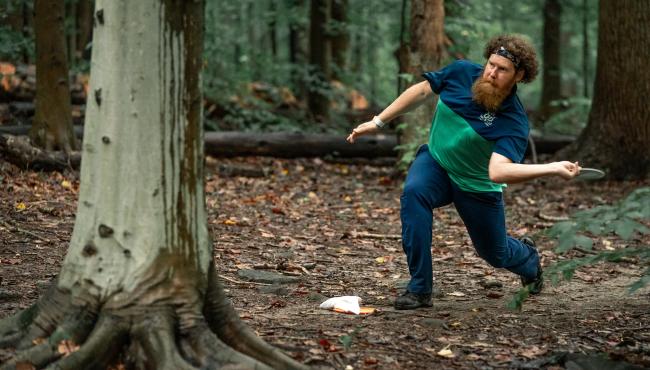Three Keys to a Better Sidearm
Three Keys to a Better Sidearm
Former world distance record holder on how to get more power and accuracy with your forehand.

In today's professional game, proficiency with both forehand and backhand shots has become the standard. Photo: Alyssa Van Lanen
When I was at my competitive peak, my biggest advantage on the course was that I was one of the only players on tour that threw the sidearm interchangeably with the backhand. This allowed me to throw the highest-percentage shot on every single hole. In today's game, most players can throw well from both wings, so owning a proficient sidearm has become a necessity.
There are many components to developing a sound sidearm technique, but these are the top three things that I teach that lead to the most radical improvement for my students.
1. Throw Facing Forward
The most common sidearm mistake I see players make is turning 90 degrees and throwing sideways across their body. Since this is exactly what you are supposed to do on the backhand, it is natural to assume that the reverse would apply for the sidearm. This is not the case.
When you throw sideways cross-body, you are throwing almost entirely with your arm. Not only do you lose power and accuracy, but you are also at a much higher risk of injury due to placing excessive strain on individual joints. Using your entire body to aid in the throw, creates more power and less stress on any one point on your body. For your run up, the lower half of your body should attempt to remain forward with the upper half of your body rotating on the backswing. The resistance created by the lower half fighting the upper half generates tension in your midsection and ultimately the torque necessary for the throw. Not only does this result in more power by using your body's core muscles, it also distributes the stress of the throw because your arm no longer has to do all the work alone.
2. Throw a Ball, Not a Frisbee
With the exception of extreme hyzers, sidearms should be thrown at around 15-degree anhyzer when the body is upright and balanced above your hips. This is much more like throwing a traditional 3/4 sidearm in baseball than it is a standard Frisbee throw, which is often released below the belt line.
When you want to throw flat, you don’t lower your arm, instead lean to the side 15-degree. If you want to throw a 15-degree hyzer, you lean to the side 30 degrees. Your arm remains at a 3/4 sidearm position relative to your body.
3. Wrist, Wrist, and More Wrist
When you throw a sidearm, you have to deliberately put spin on the disc. On the vast majority of throws, more spin is always better than less spin. This is completely different than the backhand where the disc leaves your hand automatically spinning enough. With the sidearm, you have to do all the work yourself.
Grip the disc firmly but let your wrist remain loose. During the backswing, on the farthest point back, let the weight of the disc pull your wrist back so it cocks all the way. Then at the point of release, use your wrist to spin the disc as much as you can. Every part of the sidearm from the run up to the throw itself should remain relaxed until the point of release. At that moment, snap your wrist.
Bonus: One Thing to Avoid
Don't focus on keeping the elbow close to the body. This is a shortcut to generating spin on the disc that is used when the rest of the technique is not taught properly. If you leave your elbow close to your body on a sidearm, you look like a Tyrannosaurus Rex trying to play disc golf and you will never achieve your maximum power or accuracy.
With proper technique, you can reach back and fully throw that plastic object in your hand.
Scott Stokely is a former world No. 2 and the only player to hold the world distance record simultaneously for both backhand and forehand. His autobiography, Growing Up Disc Golf, is available at Amazon.com, and information about Stokely method clinics and seminars can be found on his website.
